Management Accounting Report: Activity Based Budgeting in Rio Tinto
VerifiedAdded on 2023/06/05
|13
|4490
|65
Report
AI Summary
This report provides an in-depth analysis of activity based budgeting (ABB) and its application within the Rio Tinto Group. It begins by describing Rio Tinto's operations and then delves into the concept of ABB, outlining its features, stages, and advantages, such as improved customer relationships, competitive edge, and cost evaluation. The report highlights the differences between ABB and traditional budgeting systems, emphasizing ABB's activity-oriented approach, focus on value chain optimization, and resource allocation based on business activity effectiveness. It further discusses the significance of ABB in Rio Tinto, detailing how it aids in realizing organizational objectives and aligning business activities in a cost-effective manner. The report concludes by underscoring the importance of ABB in developing future plans and identifying vital activities that add value to the organization.
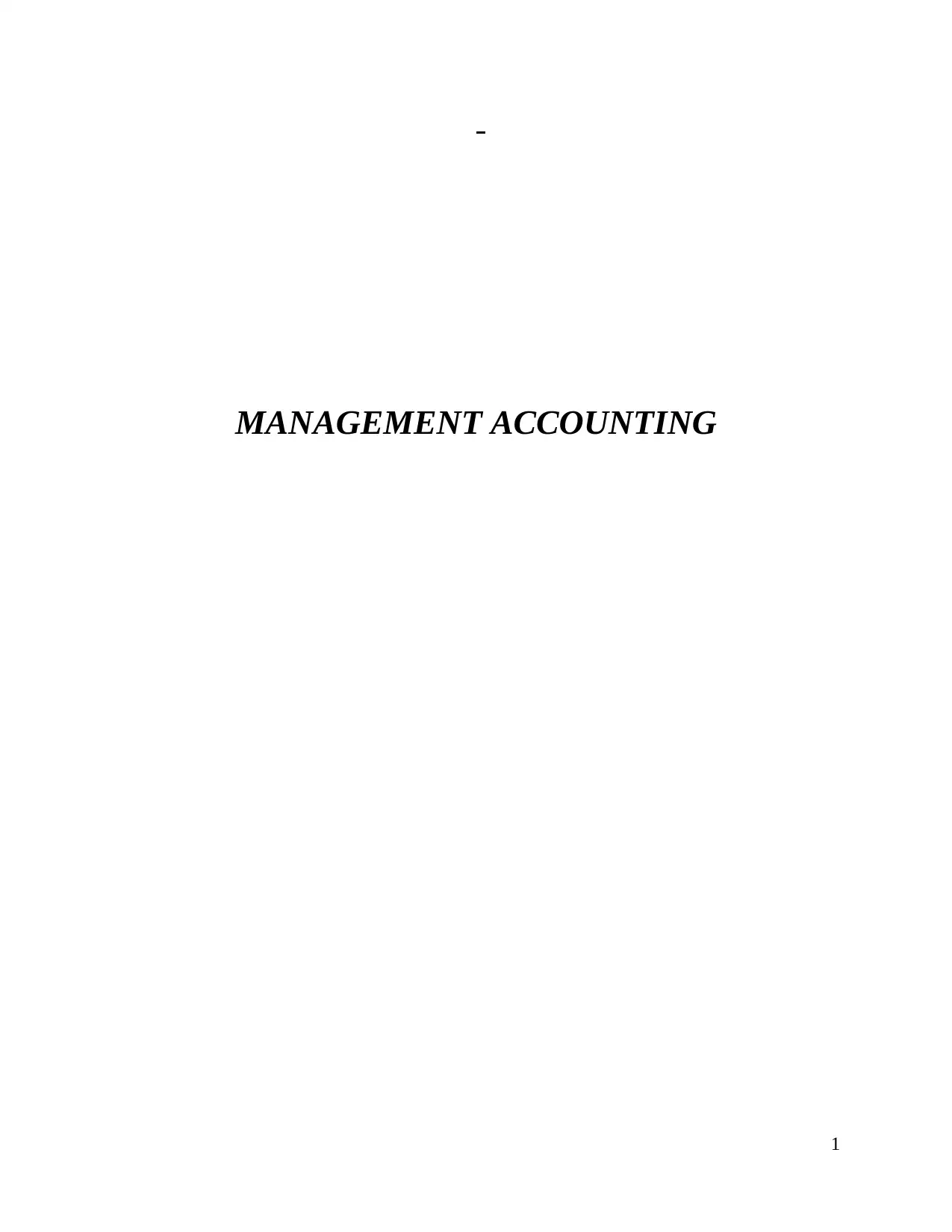
MANAGEMENT ACCOUNTING
1
1
Paraphrase This Document
Need a fresh take? Get an instant paraphrase of this document with our AI Paraphraser
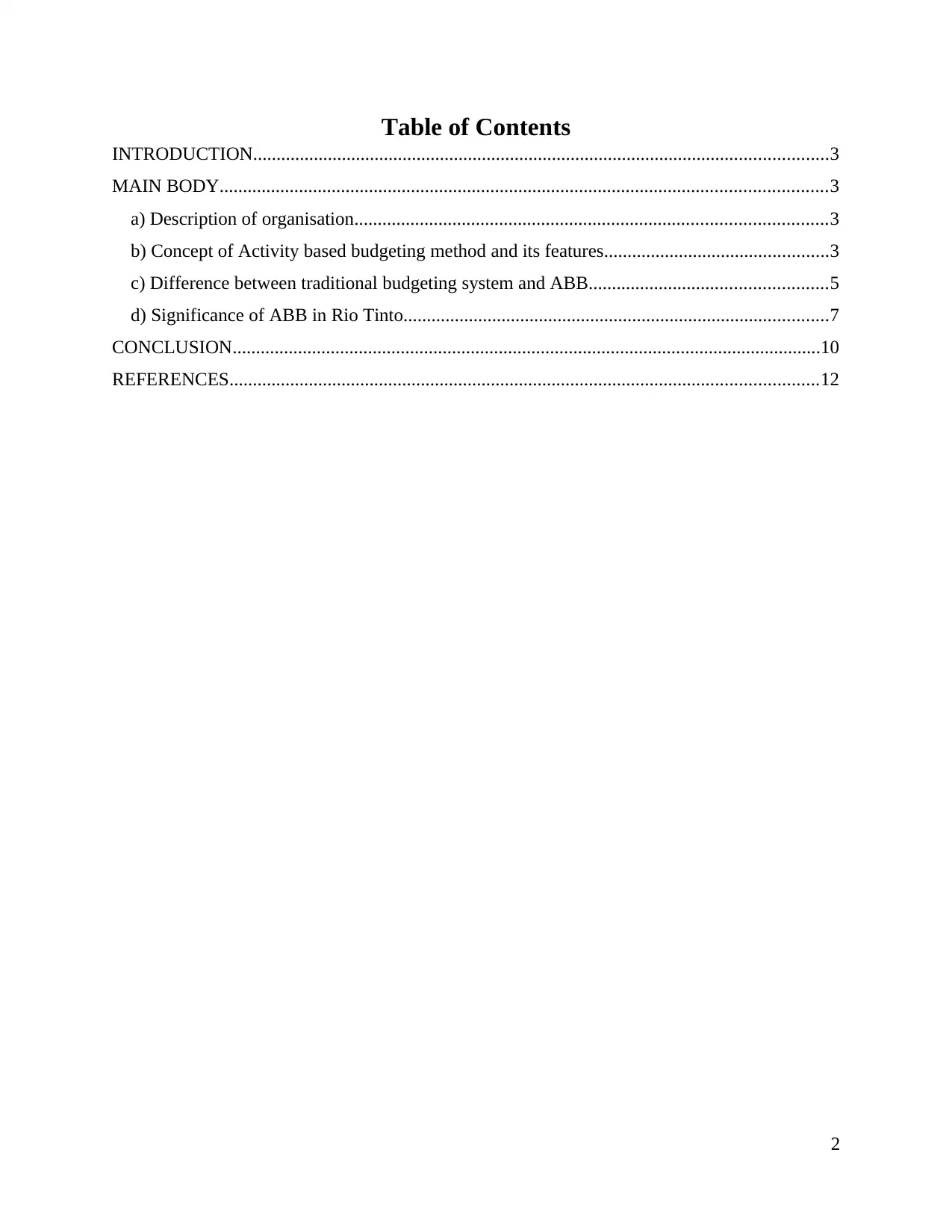
Table of Contents
INTRODUCTION...........................................................................................................................3
MAIN BODY..................................................................................................................................3
a) Description of organisation.....................................................................................................3
b) Concept of Activity based budgeting method and its features................................................3
c) Difference between traditional budgeting system and ABB...................................................5
d) Significance of ABB in Rio Tinto...........................................................................................7
CONCLUSION..............................................................................................................................10
REFERENCES..............................................................................................................................12
2
INTRODUCTION...........................................................................................................................3
MAIN BODY..................................................................................................................................3
a) Description of organisation.....................................................................................................3
b) Concept of Activity based budgeting method and its features................................................3
c) Difference between traditional budgeting system and ABB...................................................5
d) Significance of ABB in Rio Tinto...........................................................................................7
CONCLUSION..............................................................................................................................10
REFERENCES..............................................................................................................................12
2
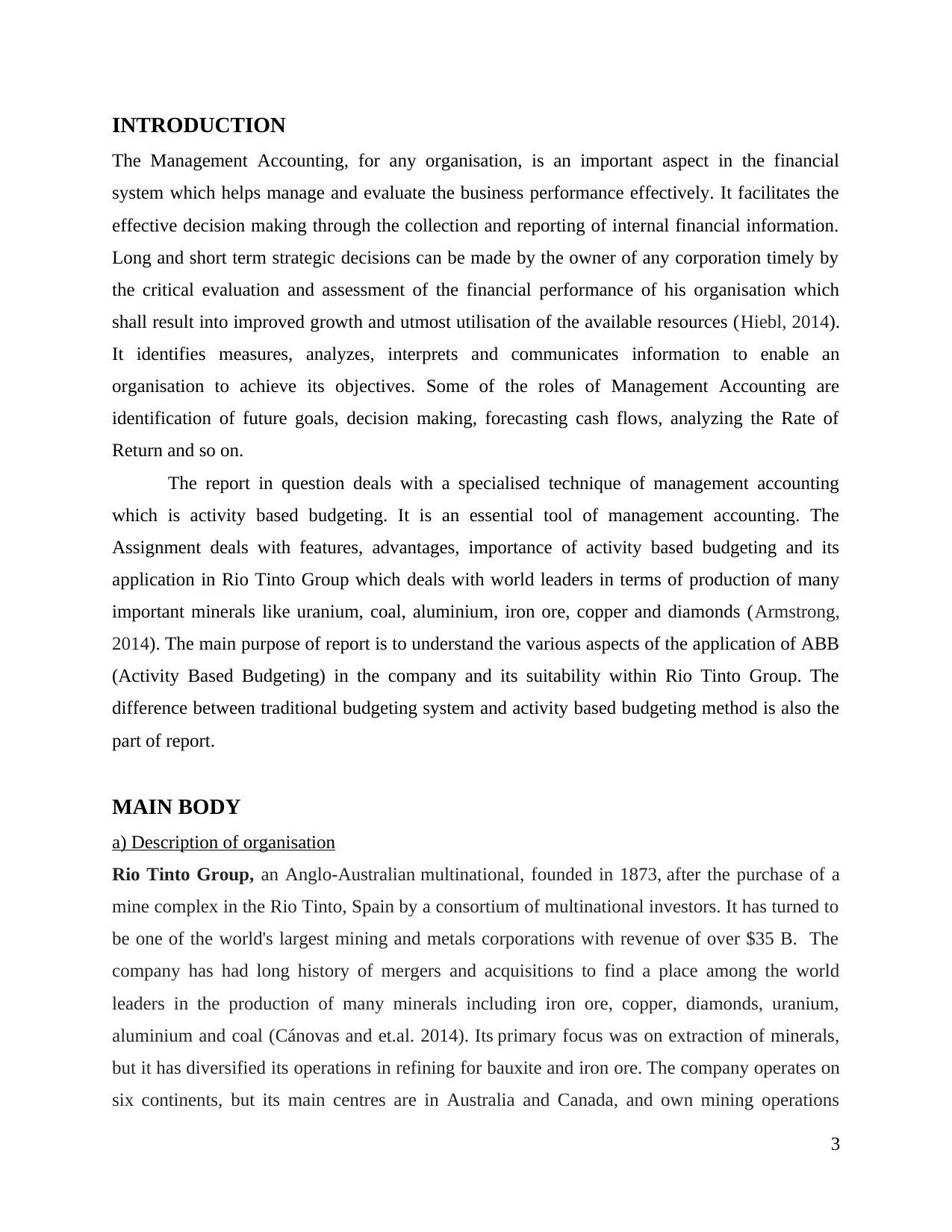
INTRODUCTION
The Management Accounting, for any organisation, is an important aspect in the financial
system which helps manage and evaluate the business performance effectively. It facilitates the
effective decision making through the collection and reporting of internal financial information.
Long and short term strategic decisions can be made by the owner of any corporation timely by
the critical evaluation and assessment of the financial performance of his organisation which
shall result into improved growth and utmost utilisation of the available resources (Hiebl, 2014).
It identifies measures, analyzes, interprets and communicates information to enable an
organisation to achieve its objectives. Some of the roles of Management Accounting are
identification of future goals, decision making, forecasting cash flows, analyzing the Rate of
Return and so on.
The report in question deals with a specialised technique of management accounting
which is activity based budgeting. It is an essential tool of management accounting. The
Assignment deals with features, advantages, importance of activity based budgeting and its
application in Rio Tinto Group which deals with world leaders in terms of production of many
important minerals like uranium, coal, aluminium, iron ore, copper and diamonds (Armstrong,
2014). The main purpose of report is to understand the various aspects of the application of ABB
(Activity Based Budgeting) in the company and its suitability within Rio Tinto Group. The
difference between traditional budgeting system and activity based budgeting method is also the
part of report.
MAIN BODY
a) Description of organisation
Rio Tinto Group, an Anglo-Australian multinational, founded in 1873, after the purchase of a
mine complex in the Rio Tinto, Spain by a consortium of multinational investors. It has turned to
be one of the world's largest mining and metals corporations with revenue of over $35 B. The
company has had long history of mergers and acquisitions to find a place among the world
leaders in the production of many minerals including iron ore, copper, diamonds, uranium,
aluminium and coal (Cánovas and et.al. 2014). Its primary focus was on extraction of minerals,
but it has diversified its operations in refining for bauxite and iron ore. The company operates on
six continents, but its main centres are in Australia and Canada, and own mining operations
3
The Management Accounting, for any organisation, is an important aspect in the financial
system which helps manage and evaluate the business performance effectively. It facilitates the
effective decision making through the collection and reporting of internal financial information.
Long and short term strategic decisions can be made by the owner of any corporation timely by
the critical evaluation and assessment of the financial performance of his organisation which
shall result into improved growth and utmost utilisation of the available resources (Hiebl, 2014).
It identifies measures, analyzes, interprets and communicates information to enable an
organisation to achieve its objectives. Some of the roles of Management Accounting are
identification of future goals, decision making, forecasting cash flows, analyzing the Rate of
Return and so on.
The report in question deals with a specialised technique of management accounting
which is activity based budgeting. It is an essential tool of management accounting. The
Assignment deals with features, advantages, importance of activity based budgeting and its
application in Rio Tinto Group which deals with world leaders in terms of production of many
important minerals like uranium, coal, aluminium, iron ore, copper and diamonds (Armstrong,
2014). The main purpose of report is to understand the various aspects of the application of ABB
(Activity Based Budgeting) in the company and its suitability within Rio Tinto Group. The
difference between traditional budgeting system and activity based budgeting method is also the
part of report.
MAIN BODY
a) Description of organisation
Rio Tinto Group, an Anglo-Australian multinational, founded in 1873, after the purchase of a
mine complex in the Rio Tinto, Spain by a consortium of multinational investors. It has turned to
be one of the world's largest mining and metals corporations with revenue of over $35 B. The
company has had long history of mergers and acquisitions to find a place among the world
leaders in the production of many minerals including iron ore, copper, diamonds, uranium,
aluminium and coal (Cánovas and et.al. 2014). Its primary focus was on extraction of minerals,
but it has diversified its operations in refining for bauxite and iron ore. The company operates on
six continents, but its main centres are in Australia and Canada, and own mining operations
3
⊘ This is a preview!⊘
Do you want full access?
Subscribe today to unlock all pages.

Trusted by 1+ million students worldwide
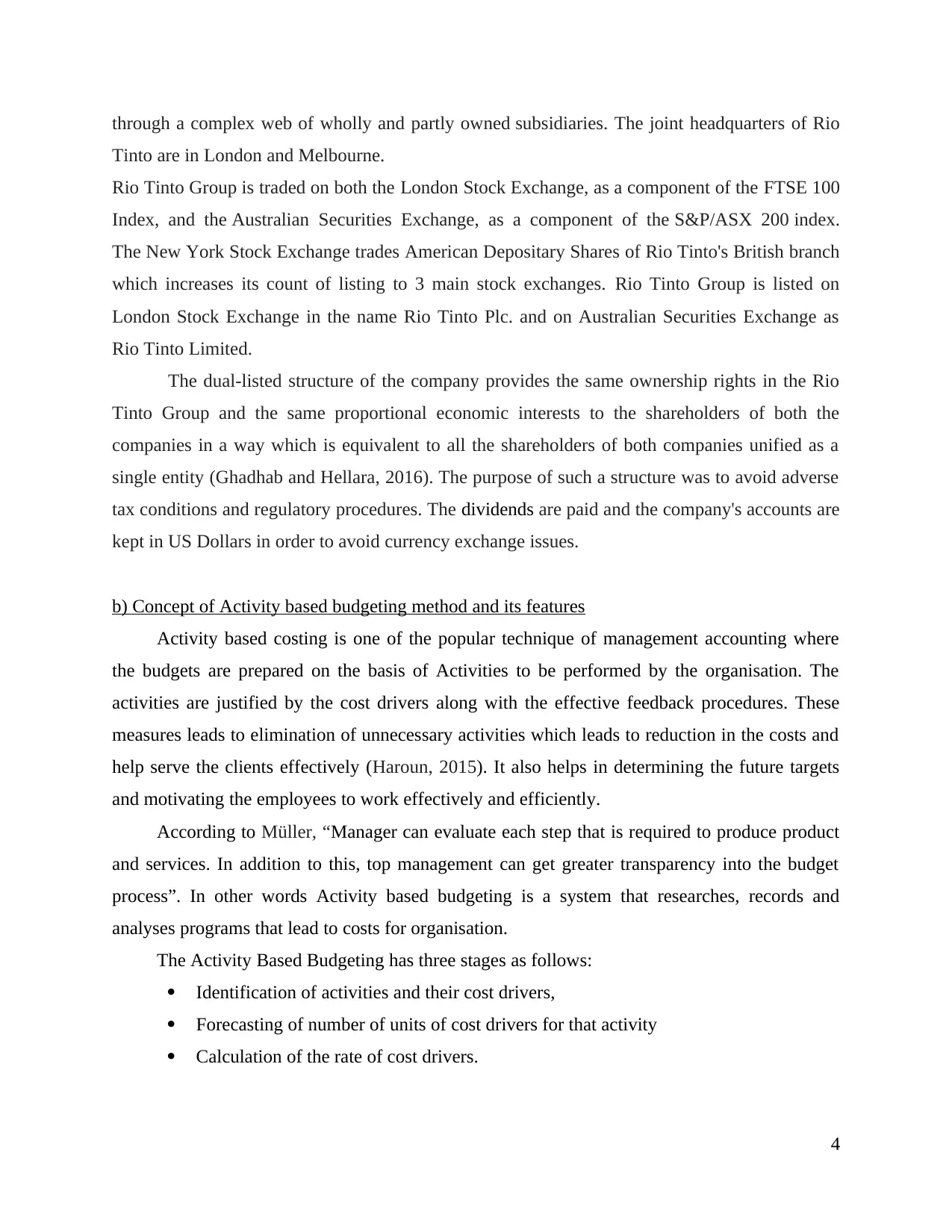
through a complex web of wholly and partly owned subsidiaries. The joint headquarters of Rio
Tinto are in London and Melbourne.
Rio Tinto Group is traded on both the London Stock Exchange, as a component of the FTSE 100
Index, and the Australian Securities Exchange, as a component of the S&P/ASX 200 index.
The New York Stock Exchange trades American Depositary Shares of Rio Tinto's British branch
which increases its count of listing to 3 main stock exchanges. Rio Tinto Group is listed on
London Stock Exchange in the name Rio Tinto Plc. and on Australian Securities Exchange as
Rio Tinto Limited.
The dual-listed structure of the company provides the same ownership rights in the Rio
Tinto Group and the same proportional economic interests to the shareholders of both the
companies in a way which is equivalent to all the shareholders of both companies unified as a
single entity (Ghadhab and Hellara, 2016). The purpose of such a structure was to avoid adverse
tax conditions and regulatory procedures. The dividends are paid and the company's accounts are
kept in US Dollars in order to avoid currency exchange issues.
b) Concept of Activity based budgeting method and its features
Activity based costing is one of the popular technique of management accounting where
the budgets are prepared on the basis of Activities to be performed by the organisation. The
activities are justified by the cost drivers along with the effective feedback procedures. These
measures leads to elimination of unnecessary activities which leads to reduction in the costs and
help serve the clients effectively (Haroun, 2015). It also helps in determining the future targets
and motivating the employees to work effectively and efficiently.
According to Müller, “Manager can evaluate each step that is required to produce product
and services. In addition to this, top management can get greater transparency into the budget
process”. In other words Activity based budgeting is a system that researches, records and
analyses programs that lead to costs for organisation.
The Activity Based Budgeting has three stages as follows:
Identification of activities and their cost drivers,
Forecasting of number of units of cost drivers for that activity
Calculation of the rate of cost drivers.
4
Tinto are in London and Melbourne.
Rio Tinto Group is traded on both the London Stock Exchange, as a component of the FTSE 100
Index, and the Australian Securities Exchange, as a component of the S&P/ASX 200 index.
The New York Stock Exchange trades American Depositary Shares of Rio Tinto's British branch
which increases its count of listing to 3 main stock exchanges. Rio Tinto Group is listed on
London Stock Exchange in the name Rio Tinto Plc. and on Australian Securities Exchange as
Rio Tinto Limited.
The dual-listed structure of the company provides the same ownership rights in the Rio
Tinto Group and the same proportional economic interests to the shareholders of both the
companies in a way which is equivalent to all the shareholders of both companies unified as a
single entity (Ghadhab and Hellara, 2016). The purpose of such a structure was to avoid adverse
tax conditions and regulatory procedures. The dividends are paid and the company's accounts are
kept in US Dollars in order to avoid currency exchange issues.
b) Concept of Activity based budgeting method and its features
Activity based costing is one of the popular technique of management accounting where
the budgets are prepared on the basis of Activities to be performed by the organisation. The
activities are justified by the cost drivers along with the effective feedback procedures. These
measures leads to elimination of unnecessary activities which leads to reduction in the costs and
help serve the clients effectively (Haroun, 2015). It also helps in determining the future targets
and motivating the employees to work effectively and efficiently.
According to Müller, “Manager can evaluate each step that is required to produce product
and services. In addition to this, top management can get greater transparency into the budget
process”. In other words Activity based budgeting is a system that researches, records and
analyses programs that lead to costs for organisation.
The Activity Based Budgeting has three stages as follows:
Identification of activities and their cost drivers,
Forecasting of number of units of cost drivers for that activity
Calculation of the rate of cost drivers.
4
Paraphrase This Document
Need a fresh take? Get an instant paraphrase of this document with our AI Paraphraser
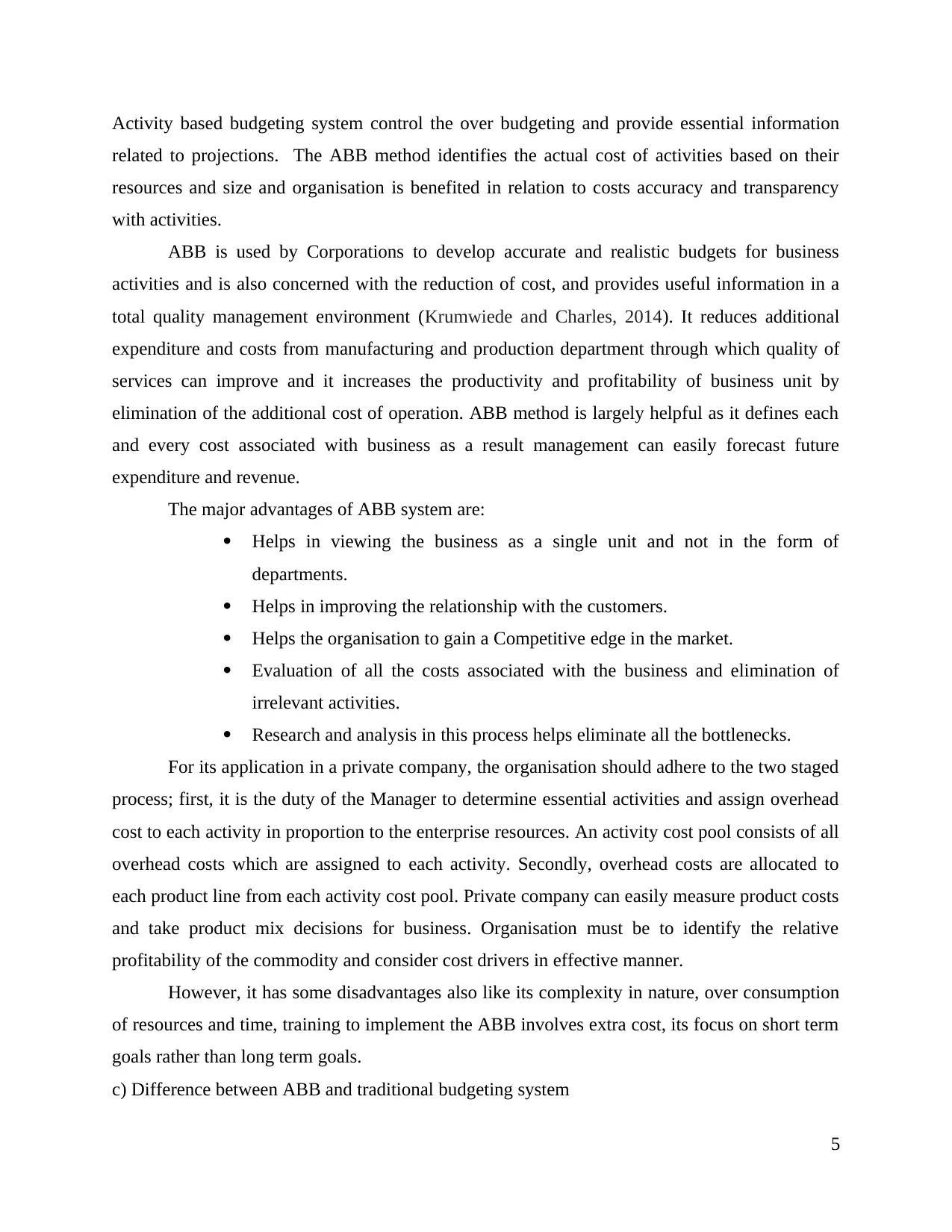
Activity based budgeting system control the over budgeting and provide essential information
related to projections. The ABB method identifies the actual cost of activities based on their
resources and size and organisation is benefited in relation to costs accuracy and transparency
with activities.
ABB is used by Corporations to develop accurate and realistic budgets for business
activities and is also concerned with the reduction of cost, and provides useful information in a
total quality management environment (Krumwiede and Charles, 2014). It reduces additional
expenditure and costs from manufacturing and production department through which quality of
services can improve and it increases the productivity and profitability of business unit by
elimination of the additional cost of operation. ABB method is largely helpful as it defines each
and every cost associated with business as a result management can easily forecast future
expenditure and revenue.
The major advantages of ABB system are:
Helps in viewing the business as a single unit and not in the form of
departments.
Helps in improving the relationship with the customers.
Helps the organisation to gain a Competitive edge in the market.
Evaluation of all the costs associated with the business and elimination of
irrelevant activities.
Research and analysis in this process helps eliminate all the bottlenecks.
For its application in a private company, the organisation should adhere to the two staged
process; first, it is the duty of the Manager to determine essential activities and assign overhead
cost to each activity in proportion to the enterprise resources. An activity cost pool consists of all
overhead costs which are assigned to each activity. Secondly, overhead costs are allocated to
each product line from each activity cost pool. Private company can easily measure product costs
and take product mix decisions for business. Organisation must be to identify the relative
profitability of the commodity and consider cost drivers in effective manner.
However, it has some disadvantages also like its complexity in nature, over consumption
of resources and time, training to implement the ABB involves extra cost, its focus on short term
goals rather than long term goals.
c) Difference between ABB and traditional budgeting system
5
related to projections. The ABB method identifies the actual cost of activities based on their
resources and size and organisation is benefited in relation to costs accuracy and transparency
with activities.
ABB is used by Corporations to develop accurate and realistic budgets for business
activities and is also concerned with the reduction of cost, and provides useful information in a
total quality management environment (Krumwiede and Charles, 2014). It reduces additional
expenditure and costs from manufacturing and production department through which quality of
services can improve and it increases the productivity and profitability of business unit by
elimination of the additional cost of operation. ABB method is largely helpful as it defines each
and every cost associated with business as a result management can easily forecast future
expenditure and revenue.
The major advantages of ABB system are:
Helps in viewing the business as a single unit and not in the form of
departments.
Helps in improving the relationship with the customers.
Helps the organisation to gain a Competitive edge in the market.
Evaluation of all the costs associated with the business and elimination of
irrelevant activities.
Research and analysis in this process helps eliminate all the bottlenecks.
For its application in a private company, the organisation should adhere to the two staged
process; first, it is the duty of the Manager to determine essential activities and assign overhead
cost to each activity in proportion to the enterprise resources. An activity cost pool consists of all
overhead costs which are assigned to each activity. Secondly, overhead costs are allocated to
each product line from each activity cost pool. Private company can easily measure product costs
and take product mix decisions for business. Organisation must be to identify the relative
profitability of the commodity and consider cost drivers in effective manner.
However, it has some disadvantages also like its complexity in nature, over consumption
of resources and time, training to implement the ABB involves extra cost, its focus on short term
goals rather than long term goals.
c) Difference between ABB and traditional budgeting system
5
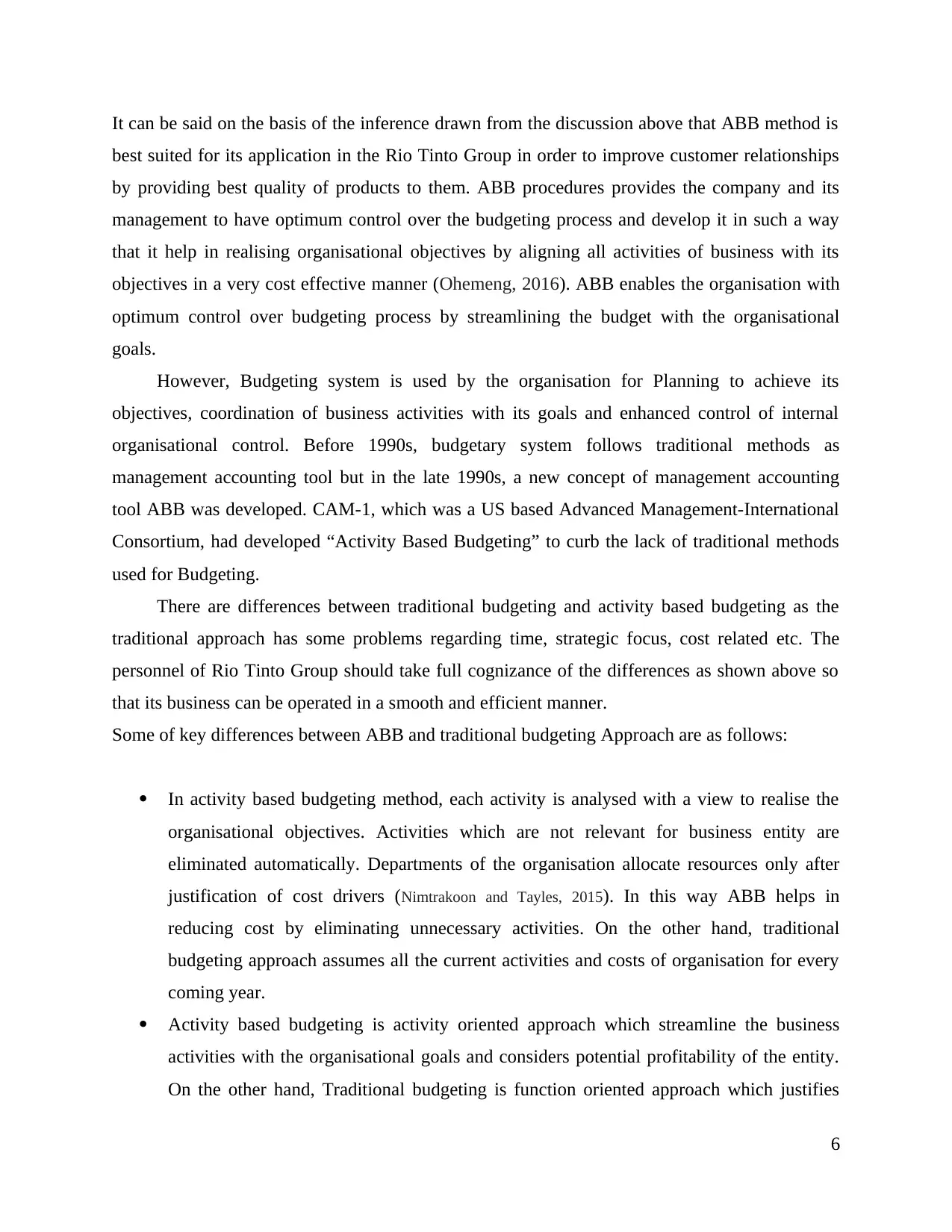
It can be said on the basis of the inference drawn from the discussion above that ABB method is
best suited for its application in the Rio Tinto Group in order to improve customer relationships
by providing best quality of products to them. ABB procedures provides the company and its
management to have optimum control over the budgeting process and develop it in such a way
that it help in realising organisational objectives by aligning all activities of business with its
objectives in a very cost effective manner (Ohemeng, 2016). ABB enables the organisation with
optimum control over budgeting process by streamlining the budget with the organisational
goals.
However, Budgeting system is used by the organisation for Planning to achieve its
objectives, coordination of business activities with its goals and enhanced control of internal
organisational control. Before 1990s, budgetary system follows traditional methods as
management accounting tool but in the late 1990s, a new concept of management accounting
tool ABB was developed. CAM-1, which was a US based Advanced Management-International
Consortium, had developed “Activity Based Budgeting” to curb the lack of traditional methods
used for Budgeting.
There are differences between traditional budgeting and activity based budgeting as the
traditional approach has some problems regarding time, strategic focus, cost related etc. The
personnel of Rio Tinto Group should take full cognizance of the differences as shown above so
that its business can be operated in a smooth and efficient manner.
Some of key differences between ABB and traditional budgeting Approach are as follows:
In activity based budgeting method, each activity is analysed with a view to realise the
organisational objectives. Activities which are not relevant for business entity are
eliminated automatically. Departments of the organisation allocate resources only after
justification of cost drivers (Nimtrakoon and Tayles, 2015). In this way ABB helps in
reducing cost by eliminating unnecessary activities. On the other hand, traditional
budgeting approach assumes all the current activities and costs of organisation for every
coming year.
Activity based budgeting is activity oriented approach which streamline the business
activities with the organisational goals and considers potential profitability of the entity.
On the other hand, Traditional budgeting is function oriented approach which justifies
6
best suited for its application in the Rio Tinto Group in order to improve customer relationships
by providing best quality of products to them. ABB procedures provides the company and its
management to have optimum control over the budgeting process and develop it in such a way
that it help in realising organisational objectives by aligning all activities of business with its
objectives in a very cost effective manner (Ohemeng, 2016). ABB enables the organisation with
optimum control over budgeting process by streamlining the budget with the organisational
goals.
However, Budgeting system is used by the organisation for Planning to achieve its
objectives, coordination of business activities with its goals and enhanced control of internal
organisational control. Before 1990s, budgetary system follows traditional methods as
management accounting tool but in the late 1990s, a new concept of management accounting
tool ABB was developed. CAM-1, which was a US based Advanced Management-International
Consortium, had developed “Activity Based Budgeting” to curb the lack of traditional methods
used for Budgeting.
There are differences between traditional budgeting and activity based budgeting as the
traditional approach has some problems regarding time, strategic focus, cost related etc. The
personnel of Rio Tinto Group should take full cognizance of the differences as shown above so
that its business can be operated in a smooth and efficient manner.
Some of key differences between ABB and traditional budgeting Approach are as follows:
In activity based budgeting method, each activity is analysed with a view to realise the
organisational objectives. Activities which are not relevant for business entity are
eliminated automatically. Departments of the organisation allocate resources only after
justification of cost drivers (Nimtrakoon and Tayles, 2015). In this way ABB helps in
reducing cost by eliminating unnecessary activities. On the other hand, traditional
budgeting approach assumes all the current activities and costs of organisation for every
coming year.
Activity based budgeting is activity oriented approach which streamline the business
activities with the organisational goals and considers potential profitability of the entity.
On the other hand, Traditional budgeting is function oriented approach which justifies
6
⊘ This is a preview!⊘
Do you want full access?
Subscribe today to unlock all pages.

Trusted by 1+ million students worldwide
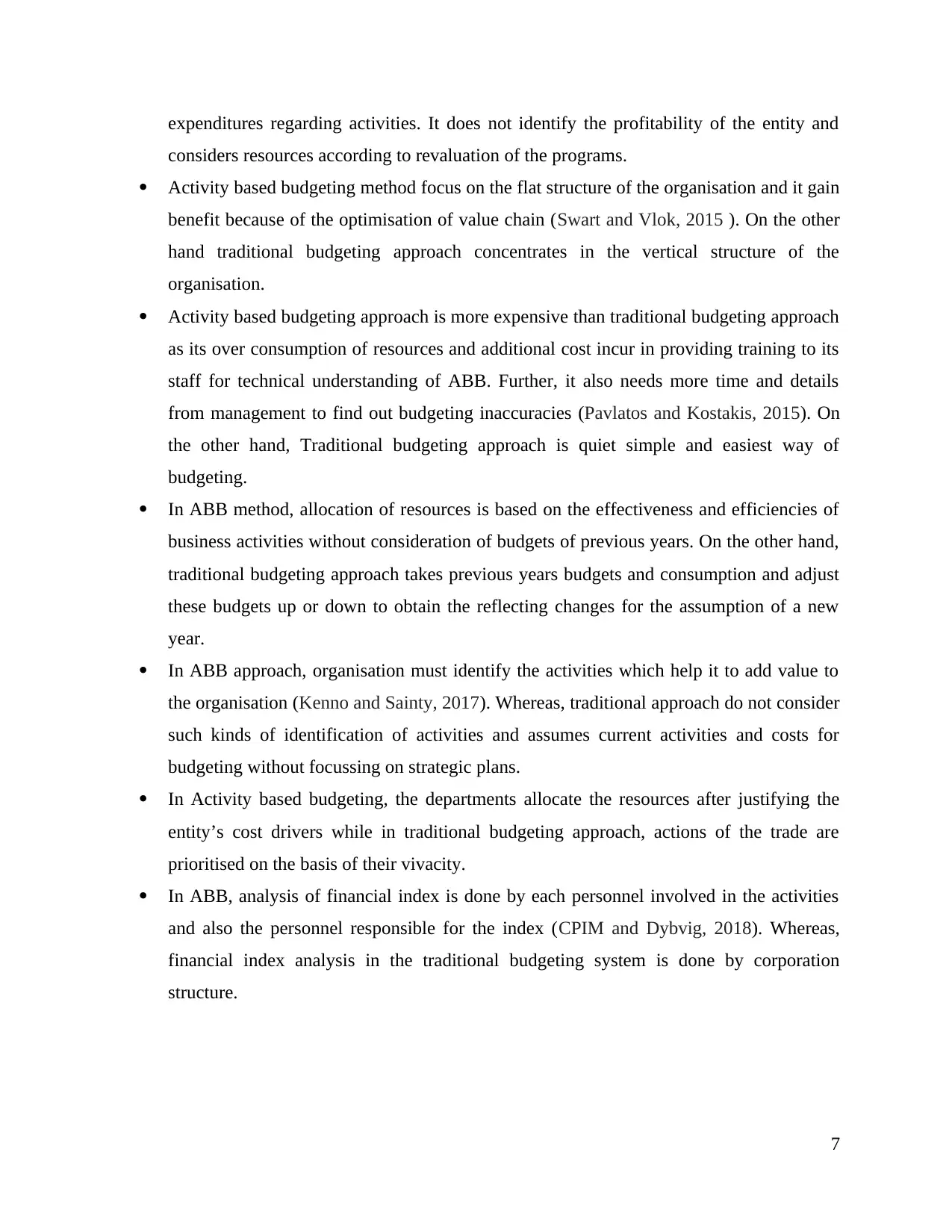
expenditures regarding activities. It does not identify the profitability of the entity and
considers resources according to revaluation of the programs.
Activity based budgeting method focus on the flat structure of the organisation and it gain
benefit because of the optimisation of value chain (Swart and Vlok, 2015 ). On the other
hand traditional budgeting approach concentrates in the vertical structure of the
organisation.
Activity based budgeting approach is more expensive than traditional budgeting approach
as its over consumption of resources and additional cost incur in providing training to its
staff for technical understanding of ABB. Further, it also needs more time and details
from management to find out budgeting inaccuracies (Pavlatos and Kostakis, 2015). On
the other hand, Traditional budgeting approach is quiet simple and easiest way of
budgeting.
In ABB method, allocation of resources is based on the effectiveness and efficiencies of
business activities without consideration of budgets of previous years. On the other hand,
traditional budgeting approach takes previous years budgets and consumption and adjust
these budgets up or down to obtain the reflecting changes for the assumption of a new
year.
In ABB approach, organisation must identify the activities which help it to add value to
the organisation (Kenno and Sainty, 2017). Whereas, traditional approach do not consider
such kinds of identification of activities and assumes current activities and costs for
budgeting without focussing on strategic plans.
In Activity based budgeting, the departments allocate the resources after justifying the
entity’s cost drivers while in traditional budgeting approach, actions of the trade are
prioritised on the basis of their vivacity.
In ABB, analysis of financial index is done by each personnel involved in the activities
and also the personnel responsible for the index (CPIM and Dybvig, 2018). Whereas,
financial index analysis in the traditional budgeting system is done by corporation
structure.
7
considers resources according to revaluation of the programs.
Activity based budgeting method focus on the flat structure of the organisation and it gain
benefit because of the optimisation of value chain (Swart and Vlok, 2015 ). On the other
hand traditional budgeting approach concentrates in the vertical structure of the
organisation.
Activity based budgeting approach is more expensive than traditional budgeting approach
as its over consumption of resources and additional cost incur in providing training to its
staff for technical understanding of ABB. Further, it also needs more time and details
from management to find out budgeting inaccuracies (Pavlatos and Kostakis, 2015). On
the other hand, Traditional budgeting approach is quiet simple and easiest way of
budgeting.
In ABB method, allocation of resources is based on the effectiveness and efficiencies of
business activities without consideration of budgets of previous years. On the other hand,
traditional budgeting approach takes previous years budgets and consumption and adjust
these budgets up or down to obtain the reflecting changes for the assumption of a new
year.
In ABB approach, organisation must identify the activities which help it to add value to
the organisation (Kenno and Sainty, 2017). Whereas, traditional approach do not consider
such kinds of identification of activities and assumes current activities and costs for
budgeting without focussing on strategic plans.
In Activity based budgeting, the departments allocate the resources after justifying the
entity’s cost drivers while in traditional budgeting approach, actions of the trade are
prioritised on the basis of their vivacity.
In ABB, analysis of financial index is done by each personnel involved in the activities
and also the personnel responsible for the index (CPIM and Dybvig, 2018). Whereas,
financial index analysis in the traditional budgeting system is done by corporation
structure.
7
Paraphrase This Document
Need a fresh take? Get an instant paraphrase of this document with our AI Paraphraser
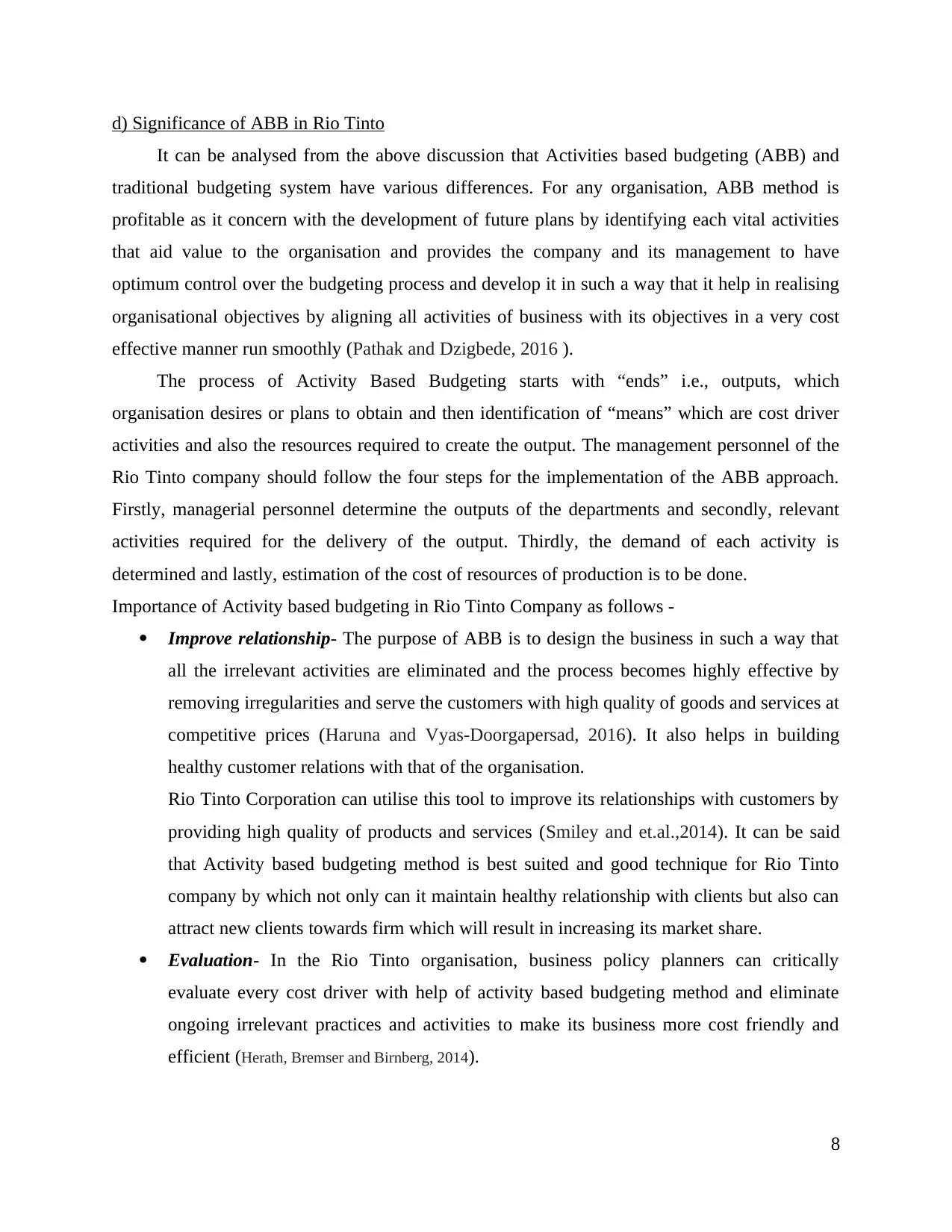
d) Significance of ABB in Rio Tinto
It can be analysed from the above discussion that Activities based budgeting (ABB) and
traditional budgeting system have various differences. For any organisation, ABB method is
profitable as it concern with the development of future plans by identifying each vital activities
that aid value to the organisation and provides the company and its management to have
optimum control over the budgeting process and develop it in such a way that it help in realising
organisational objectives by aligning all activities of business with its objectives in a very cost
effective manner run smoothly (Pathak and Dzigbede, 2016 ).
The process of Activity Based Budgeting starts with “ends” i.e., outputs, which
organisation desires or plans to obtain and then identification of “means” which are cost driver
activities and also the resources required to create the output. The management personnel of the
Rio Tinto company should follow the four steps for the implementation of the ABB approach.
Firstly, managerial personnel determine the outputs of the departments and secondly, relevant
activities required for the delivery of the output. Thirdly, the demand of each activity is
determined and lastly, estimation of the cost of resources of production is to be done.
Importance of Activity based budgeting in Rio Tinto Company as follows -
Improve relationship- The purpose of ABB is to design the business in such a way that
all the irrelevant activities are eliminated and the process becomes highly effective by
removing irregularities and serve the customers with high quality of goods and services at
competitive prices (Haruna and Vyas-Doorgapersad, 2016). It also helps in building
healthy customer relations with that of the organisation.
Rio Tinto Corporation can utilise this tool to improve its relationships with customers by
providing high quality of products and services (Smiley and et.al.,2014). It can be said
that Activity based budgeting method is best suited and good technique for Rio Tinto
company by which not only can it maintain healthy relationship with clients but also can
attract new clients towards firm which will result in increasing its market share.
Evaluation- In the Rio Tinto organisation, business policy planners can critically
evaluate every cost driver with help of activity based budgeting method and eliminate
ongoing irrelevant practices and activities to make its business more cost friendly and
efficient (Herath, Bremser and Birnberg, 2014).
8
It can be analysed from the above discussion that Activities based budgeting (ABB) and
traditional budgeting system have various differences. For any organisation, ABB method is
profitable as it concern with the development of future plans by identifying each vital activities
that aid value to the organisation and provides the company and its management to have
optimum control over the budgeting process and develop it in such a way that it help in realising
organisational objectives by aligning all activities of business with its objectives in a very cost
effective manner run smoothly (Pathak and Dzigbede, 2016 ).
The process of Activity Based Budgeting starts with “ends” i.e., outputs, which
organisation desires or plans to obtain and then identification of “means” which are cost driver
activities and also the resources required to create the output. The management personnel of the
Rio Tinto company should follow the four steps for the implementation of the ABB approach.
Firstly, managerial personnel determine the outputs of the departments and secondly, relevant
activities required for the delivery of the output. Thirdly, the demand of each activity is
determined and lastly, estimation of the cost of resources of production is to be done.
Importance of Activity based budgeting in Rio Tinto Company as follows -
Improve relationship- The purpose of ABB is to design the business in such a way that
all the irrelevant activities are eliminated and the process becomes highly effective by
removing irregularities and serve the customers with high quality of goods and services at
competitive prices (Haruna and Vyas-Doorgapersad, 2016). It also helps in building
healthy customer relations with that of the organisation.
Rio Tinto Corporation can utilise this tool to improve its relationships with customers by
providing high quality of products and services (Smiley and et.al.,2014). It can be said
that Activity based budgeting method is best suited and good technique for Rio Tinto
company by which not only can it maintain healthy relationship with clients but also can
attract new clients towards firm which will result in increasing its market share.
Evaluation- In the Rio Tinto organisation, business policy planners can critically
evaluate every cost driver with help of activity based budgeting method and eliminate
ongoing irrelevant practices and activities to make its business more cost friendly and
efficient (Herath, Bremser and Birnberg, 2014).
8

Hence, the use of ABB method can help evaluate and monitor its business operation and
remove least required programs and activities from venture.
Competitive Edge- The use of ABB technique can help organisation in sorting and
prioritising its functions and activities with the view of cost effectiveness so that it may
eliminate all sorts of irrelevant activities from its chart and develops the operation of
business in such a way to gain competitive edge in the market by providing high quality
of goods and services to the customers and develops and maintain healthy relationship
with its clients (Nielsen, 2018).
By the use of this method, organisation can deliver high quality of products and services
at minimum cost than its other competitors in market.
Thus it can be said that Activity based budgeting system is suitable and effective tool for
Rio Tinto Group to help it gain competitive edge in the market.
Elimination of bottlenecks- One of the most important function of activity based
budgeting technique is that the personnel of the organisation with the use of this
technique conducts deep analysis and research on the processes and activities of the
organisation so as to remove various types of bottlenecks associated with functions,
operation, business programs and so on (Huang and et.al., 2014). Thus, the use of ABB
may help Rio Tinto Corporation to eliminate bottlenecks and carry out all activities in
smooth and effective manner.
Deliver high quality services- The most significant function of the activity based
budgeting method is to reduce the cost of operation and improve the quality of functions
and provide the customers with quality of services and products and retain the faith of
customers for the organisation.
Focus on strategic planning- Budgeting is associated with Planning to achieve its
objectives, coordination of business activities with its goals and enhanced control of
organisational internal processes. Activity based budgeting, an innovative approach
which can help the Rio Tinto to become competitive by streamlining the budgeting
process with the strategic plans and to analysis of core competencies of the organisation
(Garousi and Pfahl, 2016). Managerial personnel can design and execute strategic plans
9
remove least required programs and activities from venture.
Competitive Edge- The use of ABB technique can help organisation in sorting and
prioritising its functions and activities with the view of cost effectiveness so that it may
eliminate all sorts of irrelevant activities from its chart and develops the operation of
business in such a way to gain competitive edge in the market by providing high quality
of goods and services to the customers and develops and maintain healthy relationship
with its clients (Nielsen, 2018).
By the use of this method, organisation can deliver high quality of products and services
at minimum cost than its other competitors in market.
Thus it can be said that Activity based budgeting system is suitable and effective tool for
Rio Tinto Group to help it gain competitive edge in the market.
Elimination of bottlenecks- One of the most important function of activity based
budgeting technique is that the personnel of the organisation with the use of this
technique conducts deep analysis and research on the processes and activities of the
organisation so as to remove various types of bottlenecks associated with functions,
operation, business programs and so on (Huang and et.al., 2014). Thus, the use of ABB
may help Rio Tinto Corporation to eliminate bottlenecks and carry out all activities in
smooth and effective manner.
Deliver high quality services- The most significant function of the activity based
budgeting method is to reduce the cost of operation and improve the quality of functions
and provide the customers with quality of services and products and retain the faith of
customers for the organisation.
Focus on strategic planning- Budgeting is associated with Planning to achieve its
objectives, coordination of business activities with its goals and enhanced control of
organisational internal processes. Activity based budgeting, an innovative approach
which can help the Rio Tinto to become competitive by streamlining the budgeting
process with the strategic plans and to analysis of core competencies of the organisation
(Garousi and Pfahl, 2016). Managerial personnel can design and execute strategic plans
9
⊘ This is a preview!⊘
Do you want full access?
Subscribe today to unlock all pages.

Trusted by 1+ million students worldwide
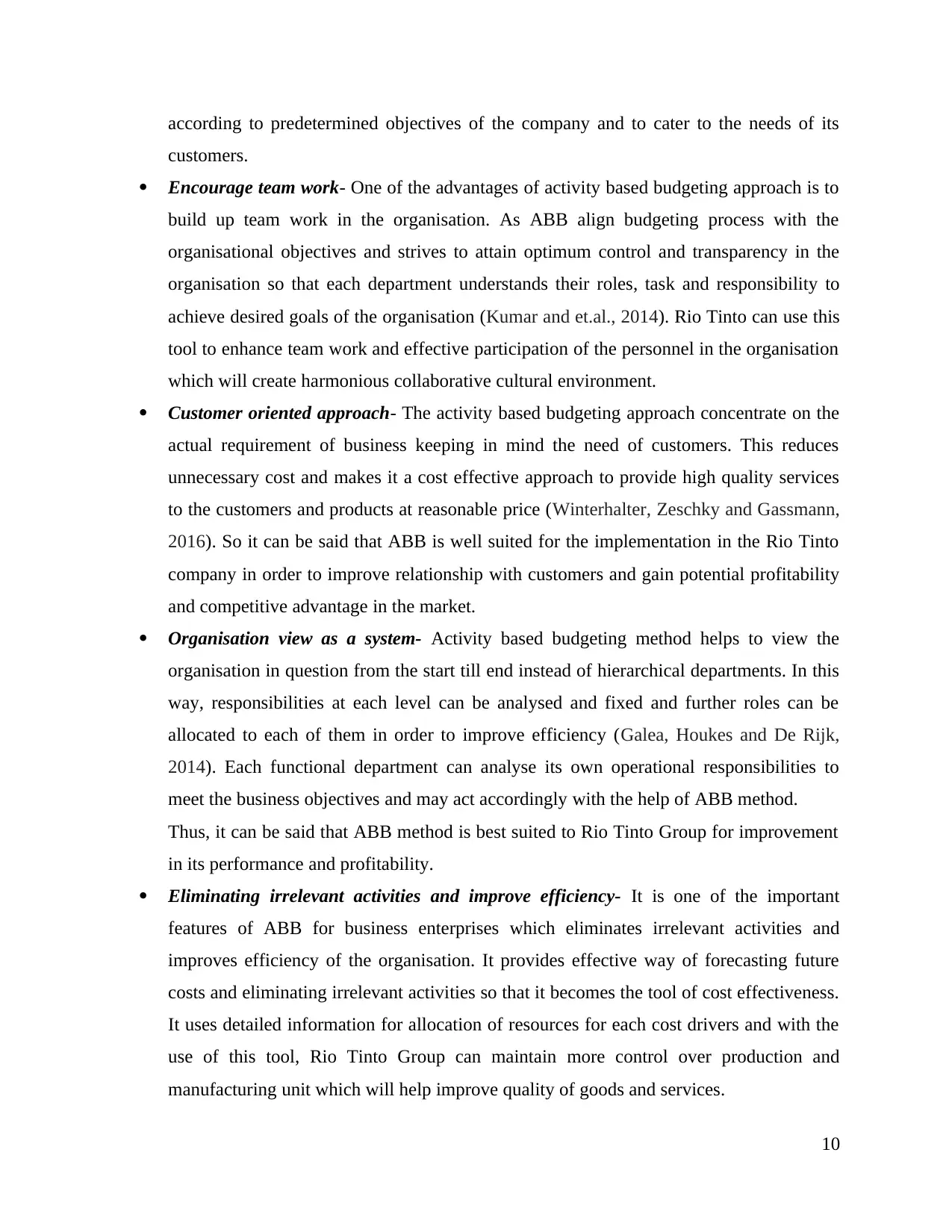
according to predetermined objectives of the company and to cater to the needs of its
customers.
Encourage team work- One of the advantages of activity based budgeting approach is to
build up team work in the organisation. As ABB align budgeting process with the
organisational objectives and strives to attain optimum control and transparency in the
organisation so that each department understands their roles, task and responsibility to
achieve desired goals of the organisation (Kumar and et.al., 2014). Rio Tinto can use this
tool to enhance team work and effective participation of the personnel in the organisation
which will create harmonious collaborative cultural environment.
Customer oriented approach- The activity based budgeting approach concentrate on the
actual requirement of business keeping in mind the need of customers. This reduces
unnecessary cost and makes it a cost effective approach to provide high quality services
to the customers and products at reasonable price (Winterhalter, Zeschky and Gassmann,
2016). So it can be said that ABB is well suited for the implementation in the Rio Tinto
company in order to improve relationship with customers and gain potential profitability
and competitive advantage in the market.
Organisation view as a system- Activity based budgeting method helps to view the
organisation in question from the start till end instead of hierarchical departments. In this
way, responsibilities at each level can be analysed and fixed and further roles can be
allocated to each of them in order to improve efficiency (Galea, Houkes and De Rijk,
2014). Each functional department can analyse its own operational responsibilities to
meet the business objectives and may act accordingly with the help of ABB method.
Thus, it can be said that ABB method is best suited to Rio Tinto Group for improvement
in its performance and profitability.
Eliminating irrelevant activities and improve efficiency- It is one of the important
features of ABB for business enterprises which eliminates irrelevant activities and
improves efficiency of the organisation. It provides effective way of forecasting future
costs and eliminating irrelevant activities so that it becomes the tool of cost effectiveness.
It uses detailed information for allocation of resources for each cost drivers and with the
use of this tool, Rio Tinto Group can maintain more control over production and
manufacturing unit which will help improve quality of goods and services.
10
customers.
Encourage team work- One of the advantages of activity based budgeting approach is to
build up team work in the organisation. As ABB align budgeting process with the
organisational objectives and strives to attain optimum control and transparency in the
organisation so that each department understands their roles, task and responsibility to
achieve desired goals of the organisation (Kumar and et.al., 2014). Rio Tinto can use this
tool to enhance team work and effective participation of the personnel in the organisation
which will create harmonious collaborative cultural environment.
Customer oriented approach- The activity based budgeting approach concentrate on the
actual requirement of business keeping in mind the need of customers. This reduces
unnecessary cost and makes it a cost effective approach to provide high quality services
to the customers and products at reasonable price (Winterhalter, Zeschky and Gassmann,
2016). So it can be said that ABB is well suited for the implementation in the Rio Tinto
company in order to improve relationship with customers and gain potential profitability
and competitive advantage in the market.
Organisation view as a system- Activity based budgeting method helps to view the
organisation in question from the start till end instead of hierarchical departments. In this
way, responsibilities at each level can be analysed and fixed and further roles can be
allocated to each of them in order to improve efficiency (Galea, Houkes and De Rijk,
2014). Each functional department can analyse its own operational responsibilities to
meet the business objectives and may act accordingly with the help of ABB method.
Thus, it can be said that ABB method is best suited to Rio Tinto Group for improvement
in its performance and profitability.
Eliminating irrelevant activities and improve efficiency- It is one of the important
features of ABB for business enterprises which eliminates irrelevant activities and
improves efficiency of the organisation. It provides effective way of forecasting future
costs and eliminating irrelevant activities so that it becomes the tool of cost effectiveness.
It uses detailed information for allocation of resources for each cost drivers and with the
use of this tool, Rio Tinto Group can maintain more control over production and
manufacturing unit which will help improve quality of goods and services.
10
Paraphrase This Document
Need a fresh take? Get an instant paraphrase of this document with our AI Paraphraser

Increase sales and thereby profitability - It is one of the important benefits of activity
based budgeting through which Rio Tinto company quite easily improve sales by
elimination of unnecessary activities from business thereby increasing potential
profitability and enables the owner to deliver quality services to the customers of the
business entity.
CONCLUSION
By encapsulation of the entire report, it can be said that Activity based budgeting method
requires to determine the planned activities, cost, size and resources to be required. It requires
detailed information and is quite different from traditional approach of budgeting. With an
effective ABB, an organisation can have optimum control over budget process, improve
customer relationship, enhance its productivity and performance effectively and efficiently and
also increase potential profitability and sales as it focuses on alignment of business activities
with the realisation of organisational goals and objectives in a very cost effective manner. The
tool of management accounting “Activity Based Budgeting (ABB)” is best suited for the Rio
Tinto Corporation as this approach eliminates irrelevant activities of the business and also the
trouble of incompatibility of the strategic plans with that of market. It is also concluded that,
however, ABB does not unravel all the problems associated with the traditional approach and is
relatively more expensive but besides all these cons, it has great significance in budgeting as a
management accounting tool as it eliminates irrelevant activities and their cost from the business
entity.
.
11
based budgeting through which Rio Tinto company quite easily improve sales by
elimination of unnecessary activities from business thereby increasing potential
profitability and enables the owner to deliver quality services to the customers of the
business entity.
CONCLUSION
By encapsulation of the entire report, it can be said that Activity based budgeting method
requires to determine the planned activities, cost, size and resources to be required. It requires
detailed information and is quite different from traditional approach of budgeting. With an
effective ABB, an organisation can have optimum control over budget process, improve
customer relationship, enhance its productivity and performance effectively and efficiently and
also increase potential profitability and sales as it focuses on alignment of business activities
with the realisation of organisational goals and objectives in a very cost effective manner. The
tool of management accounting “Activity Based Budgeting (ABB)” is best suited for the Rio
Tinto Corporation as this approach eliminates irrelevant activities of the business and also the
trouble of incompatibility of the strategic plans with that of market. It is also concluded that,
however, ABB does not unravel all the problems associated with the traditional approach and is
relatively more expensive but besides all these cons, it has great significance in budgeting as a
management accounting tool as it eliminates irrelevant activities and their cost from the business
entity.
.
11
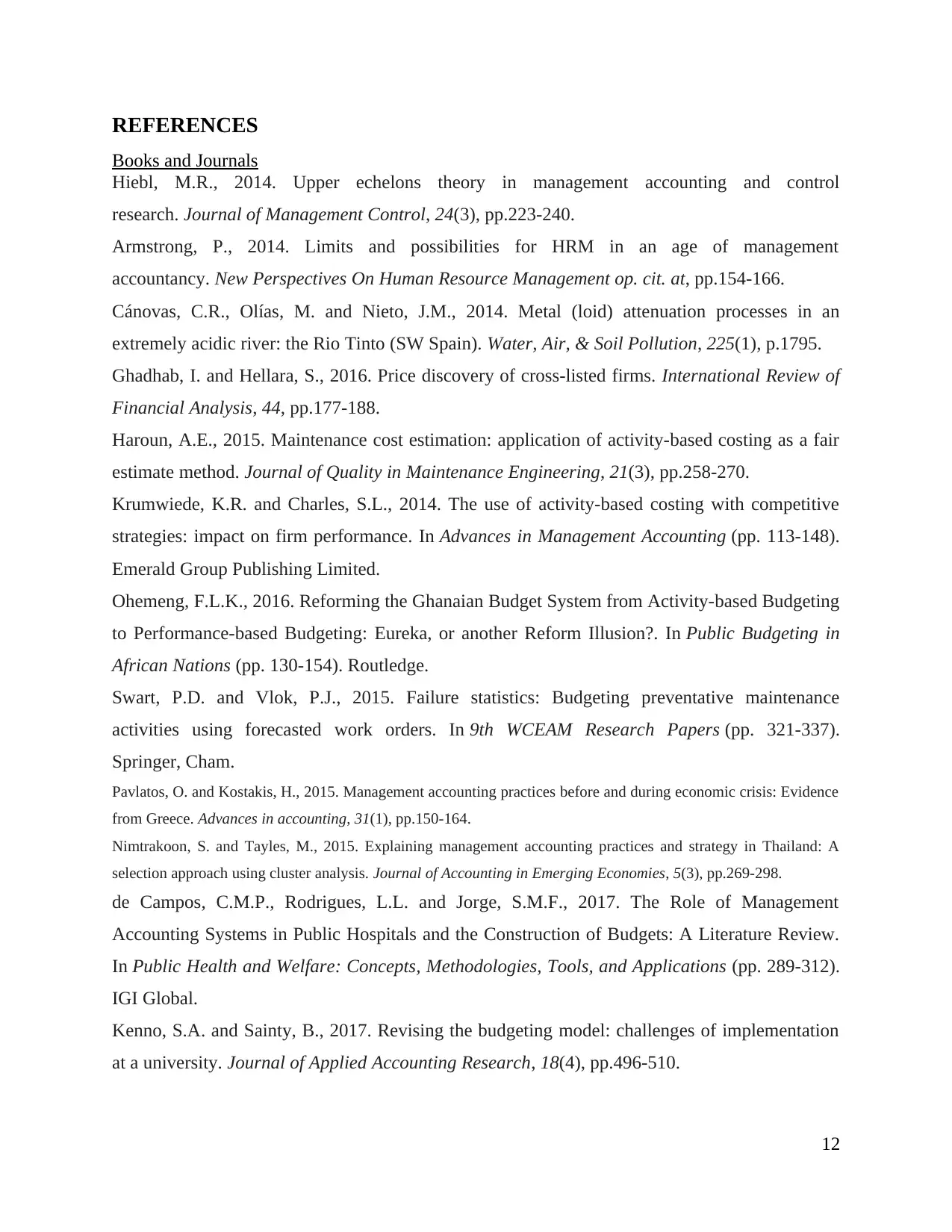
REFERENCES
Books and Journals
Hiebl, M.R., 2014. Upper echelons theory in management accounting and control
research. Journal of Management Control, 24(3), pp.223-240.
Armstrong, P., 2014. Limits and possibilities for HRM in an age of management
accountancy. New Perspectives On Human Resource Management op. cit. at, pp.154-166.
Cánovas, C.R., Olías, M. and Nieto, J.M., 2014. Metal (loid) attenuation processes in an
extremely acidic river: the Rio Tinto (SW Spain). Water, Air, & Soil Pollution, 225(1), p.1795.
Ghadhab, I. and Hellara, S., 2016. Price discovery of cross-listed firms. International Review of
Financial Analysis, 44, pp.177-188.
Haroun, A.E., 2015. Maintenance cost estimation: application of activity-based costing as a fair
estimate method. Journal of Quality in Maintenance Engineering, 21(3), pp.258-270.
Krumwiede, K.R. and Charles, S.L., 2014. The use of activity-based costing with competitive
strategies: impact on firm performance. In Advances in Management Accounting (pp. 113-148).
Emerald Group Publishing Limited.
Ohemeng, F.L.K., 2016. Reforming the Ghanaian Budget System from Activity-based Budgeting
to Performance-based Budgeting: Eureka, or another Reform Illusion?. In Public Budgeting in
African Nations (pp. 130-154). Routledge.
Swart, P.D. and Vlok, P.J., 2015. Failure statistics: Budgeting preventative maintenance
activities using forecasted work orders. In 9th WCEAM Research Papers (pp. 321-337).
Springer, Cham.
Pavlatos, O. and Kostakis, H., 2015. Management accounting practices before and during economic crisis: Evidence
from Greece. Advances in accounting, 31(1), pp.150-164.
Nimtrakoon, S. and Tayles, M., 2015. Explaining management accounting practices and strategy in Thailand: A
selection approach using cluster analysis. Journal of Accounting in Emerging Economies, 5(3), pp.269-298.
de Campos, C.M.P., Rodrigues, L.L. and Jorge, S.M.F., 2017. The Role of Management
Accounting Systems in Public Hospitals and the Construction of Budgets: A Literature Review.
In Public Health and Welfare: Concepts, Methodologies, Tools, and Applications (pp. 289-312).
IGI Global.
Kenno, S.A. and Sainty, B., 2017. Revising the budgeting model: challenges of implementation
at a university. Journal of Applied Accounting Research, 18(4), pp.496-510.
12
Books and Journals
Hiebl, M.R., 2014. Upper echelons theory in management accounting and control
research. Journal of Management Control, 24(3), pp.223-240.
Armstrong, P., 2014. Limits and possibilities for HRM in an age of management
accountancy. New Perspectives On Human Resource Management op. cit. at, pp.154-166.
Cánovas, C.R., Olías, M. and Nieto, J.M., 2014. Metal (loid) attenuation processes in an
extremely acidic river: the Rio Tinto (SW Spain). Water, Air, & Soil Pollution, 225(1), p.1795.
Ghadhab, I. and Hellara, S., 2016. Price discovery of cross-listed firms. International Review of
Financial Analysis, 44, pp.177-188.
Haroun, A.E., 2015. Maintenance cost estimation: application of activity-based costing as a fair
estimate method. Journal of Quality in Maintenance Engineering, 21(3), pp.258-270.
Krumwiede, K.R. and Charles, S.L., 2014. The use of activity-based costing with competitive
strategies: impact on firm performance. In Advances in Management Accounting (pp. 113-148).
Emerald Group Publishing Limited.
Ohemeng, F.L.K., 2016. Reforming the Ghanaian Budget System from Activity-based Budgeting
to Performance-based Budgeting: Eureka, or another Reform Illusion?. In Public Budgeting in
African Nations (pp. 130-154). Routledge.
Swart, P.D. and Vlok, P.J., 2015. Failure statistics: Budgeting preventative maintenance
activities using forecasted work orders. In 9th WCEAM Research Papers (pp. 321-337).
Springer, Cham.
Pavlatos, O. and Kostakis, H., 2015. Management accounting practices before and during economic crisis: Evidence
from Greece. Advances in accounting, 31(1), pp.150-164.
Nimtrakoon, S. and Tayles, M., 2015. Explaining management accounting practices and strategy in Thailand: A
selection approach using cluster analysis. Journal of Accounting in Emerging Economies, 5(3), pp.269-298.
de Campos, C.M.P., Rodrigues, L.L. and Jorge, S.M.F., 2017. The Role of Management
Accounting Systems in Public Hospitals and the Construction of Budgets: A Literature Review.
In Public Health and Welfare: Concepts, Methodologies, Tools, and Applications (pp. 289-312).
IGI Global.
Kenno, S.A. and Sainty, B., 2017. Revising the budgeting model: challenges of implementation
at a university. Journal of Applied Accounting Research, 18(4), pp.496-510.
12
⊘ This is a preview!⊘
Do you want full access?
Subscribe today to unlock all pages.

Trusted by 1+ million students worldwide
1 out of 13
Related Documents
Your All-in-One AI-Powered Toolkit for Academic Success.
+13062052269
info@desklib.com
Available 24*7 on WhatsApp / Email
![[object Object]](/_next/static/media/star-bottom.7253800d.svg)
Unlock your academic potential
Copyright © 2020–2025 A2Z Services. All Rights Reserved. Developed and managed by ZUCOL.





